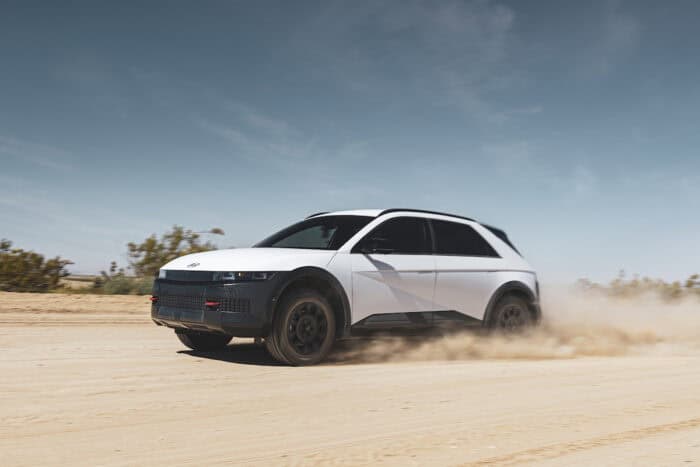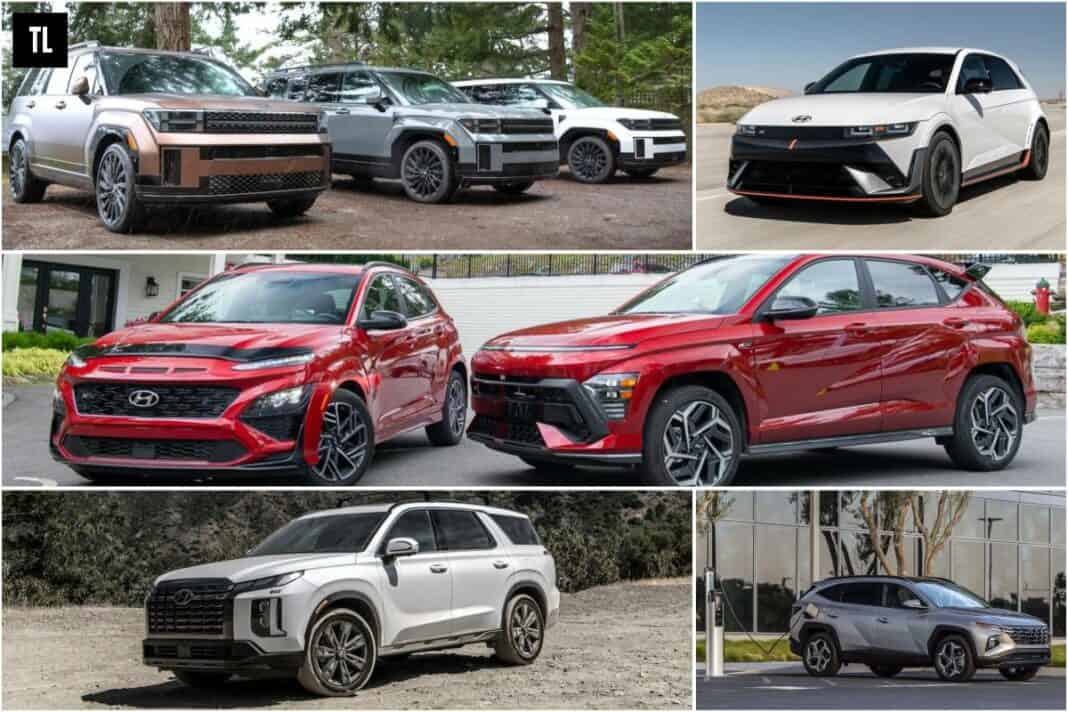This guide is continuously updated for relevance, accuracy, and the most recent info.
Hyundai’s SUV game is strong. The Korean basically has all the bases covered from subcompact Venue to 3-row Palisdade. Plus, the hydrogen-powered NEXO and hybrid options across the board. Only thing missing is a proper full-size SUV. But know one is on the way. Here’s a look at each model out now:
- Venue
- Kona – Gas
- Kona Electric
- NEXO
- IONIQ 5 (IONIQ 5 N, IONIQ 5 XRT)
- Tucson – Gas
- Tucson Hybrid
- Tucson PHEV
- Santa Fe – Gas
- Santa Fe Hybrid
- Palisade
Hyundai Venue (Subcompact Crossover SUV)

Key features:
Standard 2nd-row dual USB charging
Upgraded 6-speaker audio system
2024 Tucson gains much-needed updates
The Hyundai Venue, introduced in 2020, marks the brand’s entry into the competitive subcompact crossover category. Tailored for city living, the Venue combines the appearance of a traditional SUV with hatchback practicality in a compact design. Hyundai’s commitment to value is evident in the Venue, offering a wealth of standard features at an attractive price. The 2024 model introduces significant upgrades, including standard 2nd-row dual USB charging in SEL and Limited trims, Proximity key with push-button start now available in both SEL and Limited trims, and an upgraded 6-speaker audio system across SE, SEL, and Limited trims, enhancing overall convenience and interior features for an advanced driving experience.
Hyundai Kona – Gas (Subcompact Crossover SUV)

Key features:
More refined looks inside and out
147 hp from updated 2.0L gas engine
Kona N Line’s enhanced sporty upgrades
Completely redesigned for 2024 with sleeker looks inside and out, the Kona gas-powered model offers dual gasoline powertrain options. Including the 2.0L 4-cylinder engine with 147 horsepower and 132 lb. ft of torque and the more potent 1.6L 4-cylinder direct-injected, turbocharged engine with 190 horsepower and 195 lb. ft of torque.
Kona N Line

Unfortunately, Hyundai swiftly axed the 276 horsepower, track-ready Kona N for 2023. While the new Kona N Line with the 1.6L engine is nowhere near the N’s performance level, it does retain that sporty appeal. The N Line model features body-colour cladding, 19-inch N Line alloy wheels, a rear spoiler, dual-outlet exhaust tips, Bose premium audio, sport seating with red accents, aluminum sport pedals, scuff plates, and black mirrors. In contrast, its aggressive, wing-shaped front and rear fascia designs underscore a lowered stance for a heightened sporty aesthetic.
Related – Kona reviews and news
Hyundai Kona Electric (EV Subcompact Crossover SUV)

Key features:
260 miles electric range (estimated)
10% to 80% charge in about 43 minutes
Forward “frunk” storage
With this second-generation Kona redesign comes an all-electric version. The Kona Electric, equipped with a 64.8-kWh battery, is promising an estimated 260 miles based on Hyundai’s internal testing, and the standard battery offers approximately 197 miles of range. The battery system can recharge from 10 percent to 80 percent in about 43 minutes with 400V fast-charging capability. The Kona Electric variant is expected to be available in late fall of 2023.

Compared to the gas version, the Kona EV features battery preconditioning for secure charging in cold temperatures and a night-visible charging port door lamp. Distinctive elements include forward “frunk” storage, active grille shutters, and Vehicle-to-Load (V2L) capability. The i-PEDAL mode and Smart Regenerative System adapt to real-time traffic conditions. With a bi-directional onboard charger, the V2L function can power devices or charge equipment, supporting electric bicycles and more. The front charging port, with an available V2L adapter, allows battery-powered device use when the car is parked.
Recommended Read: Up Close with the 2024 Hyundai Kona Electric
Hyundai NEXO (Hydrogen Fuel Cell Compact Crossover SUV)

Key features:
World’s first dedicated hydrogen-powered SUV
Hyundai’s Lifetime Battery Warranty
Better than the Tucson fuel cell
First introduced for the 2019 model year, the NEXO fuel-cell SUV is a unique offering in the Hyundai SUV roster — and the world’s first dedicated hydrogen-powered SUV. The 2024 NEXO hasn’t changed much since it first arrived, aside from some trim tweaks and updates along the way. The NEXO provides clean emissions with only water vapor. As the sole mass-produced fuel cell SUV for the North American market, NEXO offers an impressive estimated range of 380 miles, and Hyundai’s Lifetime Battery Warranty backs the battery. Compared to the Tucson fuel cell, the NEXO offered enhanced acceleration and increased power with 161 peak horsepower (120 kW) and 291 lb. ft of torque.
Hyundai IONIQ 5 (Electric Compact Crossover SUV)

Key features:
The bold, hatchback-style design
Very open, spacious cabin with great storage
The 641 horsepower IONIQ 5 N
Few productions vehicles resemble their concept variants, but the IONIQ 5 is a rare exception, sporting futuristic looks unlike any other compact SUV out there now. First arriving for the 2022 model year, the IONIQ 5 offers ultra-fast 800-volt multi-charging, achieving 10 to 80 percent in just 18 minutes with a driving range exceeding 300 miles. The New E-GMP platform enhances driving dynamics while optimizing interior volume, providing the spaciousness of a large car in a compact SUV.
IONIQ 5 N

Hyundai is forgiven for abandoning the high-performance Kona N with the arrival of this stellar little rocket. The IONIQ 5 N showcases advanced electric propulsion with battery cooling, N Brake Regen, and 641 horsepower generated from an 84 kWh battery. Performance features include N Grin Boost, N Launch Control, and Track SOC for enhanced power, optimal starts, and lap-by-lap battery consumption calculation on the track. Its exterior boasts a wing-type spoiler, orange-accented rear diffuser, and aerodynamic air outlet for aggressive styling. And, yes, it has a rear window washer and wiper.
IONIQ 5 XRT

Positioned between the standard model and the N, the XRT features a 23 mm lift, all-terrain tires, and 18-inch rally-inspired wheels. Yes, a rugged IONIQ 5 EV, Hyundai went there. With new styling elements like digital camouflage cladding and unique front and rear fascias, the XRT is aimed at drivers seeking a more adventurous EV. The 2025 IONIQ 5 also gets larger batteries, improving range across all models. Here’s the full story: New Rugged XRT Adds Even More Versatility to the IONIQ 5 Lineup.
Related:
- A 641 Horsepower Corner Carver: The 2025 IONIQ 5 N Debuts at LA Auto Show
- Inside the 2022 Hyundai IONIQ 5 EV Compact SUV
- IONIQ 5 Dimension Specs: Sizing Up Hyundai’s Sleek New EV
Hyundai Tucson – Gas (Compact Crossover SUV)

Key features:
Complete redesign in 2022
Heated seats & steering wheel available
The Performance-oriented Tucson N Line
One of the more familiar nameplates in the Hyundai lineup, Tucson, received a complete redesign for the 2022 model year. The eight-inch touchscreen (a 10.25-inch is available) placed on top of the dashboard really opens up the cabin. Heated front seats, heated rear seats, and heated steering wheel are available, as well as ventilated front seats. Under the hood is a 2.5L four-cylinder that pushes 187 horsepower and makes 178 lb. ft of torque.
Tucson N Line

Yes, even Tucson gets the N treatment. The next-generation 2024 Tucson N Line introduces a performance-oriented design, featuring a taller rectangular-shaped bumper beneath the grille for a sportier aesthetic and enhanced air intake. At the rear, a lengthened aerodynamic spoiler and fins contribute to a distinctive look. The interior is adorned with black suede N-branded sporty seats featuring red contrast stitching for a sophisticated appearance. Final touches of N design elements are evident on the dedicated N steering wheel, leather gear shift knob, and shift-by-wire console cover.
Hyundai Tucson Hybrid (Hybrid Compact Crossover SUV)

Key features:
30% improved fuel economy vs. gas model
226 horsepower
20% more torque than gas model
Compared to the gas-powered Tuscan with the 2.5L, this hybrid version gets a 30 percent improvement in fuel efficiency. The hybrid powertrain includes the 1.6L turbocharged gasoline engine with 177 horsepower and 195 lb. ft. of torque, resulting in a total system combined horsepower of 226. The configuration incorporates a 44.2 kW electric motor and a 1.49 kWh battery pack, putting down an impressive 258 lb. ft. of torque — a 20 percent increase versus the Tucson gas model—the engine pairs with the HEV-tuned six-speed automatic transmission.
Related – 2022 Hyundai Tucson Hybrid Review
Hyundai Tucson Plug-In Hybrid (PHEV Compact Crossover SUV)

Key features:
Turbo 1.6L with 28 mile range from motor
Level-2 charges in under 2 hours with on-board charger
Fuel economy of over 70 MPGe
The Tuscan PHEV also finds the 1.6L turbo, but the specs differ slightly from the Hybrid. Paired with a six-speed automatic transmission, the Tucson PHEV’s battery is larger than the hybrid battery, with 13.8 kWh of power, yielding an estimated all-electric range (AER) of 28 miles and an estimated fuel economy of over 70 MPGe. According to Hyundai, the PHEV level-2 charging capability takes less than two hours to recharge the system, using a 7.2kW on-board charger. The Plug-in Hybrid powerplant delivers power through a PHEV-tuned six-speed automatic transmission for smoothness and efficiency.
Hyundai Santa Fe (Mid-Size SUV)
Key features:
2024 model offers two powertrains: gas and hybrid
New, wider liftgate for more openness
Santa Fe XRT’s high ground clearance & black styling
The elder statesman in Hyundai’s SUV roster, the Santa Fe, has seen a lot of changes over the years, from significant style updates to follow Hyundai’s evolving design language to briefly seeing a third-row option at one stage. It received a complete redesign in 2019, a refresh in 2021, and now, for 2024, this thing is an entirely different machine. Yes, it’s still a Santa Fe. And the new XRT trim adds more off-ready features with blacked-out styling upgrades.

Under the hood, the 2.5L turbocharged gasoline engine generates 277 horsepower at 5,800 rpm and 311 lb. ft. of torque at 1,700 – 4,000 rpm. The longer wheelbase enhances third-row seating and provides the most spacious interior and tailgate opening in its class, resembling a terrace-like space. Premium features include a Relaxation Seat with Leg Rest, UV-C Sterilization Tray, dual wireless charging system for smartphones, Panoramic Curved Display, and more.
Related:
- First Drive: 2024 Hyundai Santa Fe XRT Review
- First Drive: 2024 Hyundai Santa Fe Ultimate Calligraphy Review
Hyundai Santa Fe Hybrid (Hybrid Mid-Size SUV)
Key features:
1.6L Turbocharged Hybrid (no PHEV)
Increase in second-row legroom
Third-row legroom has expanded
The hybrid variant powertrain is a 1.6L Turbocharged Hybrid with a maximum output of 232 horsepower at 5,600 rpm and 271 lb. ft. of torque at 1,000 – 4,100 rpm. There is a Santa Fe plug-in hybrid (PHEV) model, but only in Europe, so North America only gets the turbo gas and turbo hybrid. The new Santa Fe Hybrid also offers a 20 mm increase in second-row legroom, extending it to 1,055 mm. Additionally, the third-row legroom has expanded by 15 mm, now measuring 761 mm in length. At time of writing, Hyundai didn’t provide any fuel economy figures; stay tuned.
Related – Santa Fe reviews and news
Hyundai Palisade (Mid-Size SUV)

Key features:
Calligraphy Night Edition trim new for 2024
Dual Automatic Temperature Control now standard from SEL & up
Last major update/redesign was 2023
The largest Hyundai SUV introduced in 2020 (yet not quite a full-size SUV), the Palisade is your attractive family hauler—and ideal road trip vehicle, no matter the party size. The mid-size SUV received a significant update for 2023, including a newer exterior look with sleek design cues (new front and rear bumper fascia, new front grille, new multi-spoke alloy wheel design, and more).
The 2024 Hyundai Palisade brings notable changes, including introducing the Calligraphy Night Edition trim and upgraded interior features. Dual Automatic Temperature Control is now standard from SEL trims and up, along with 2nd Row Automatic Temperature Control. Manual Rear Side Window Sunshades are extended to XRT and higher trims, while Ambient Lighting becomes standard in Calligraphy models.
Related – Palisade reviews and news
- 300
- 1.3Kshares




